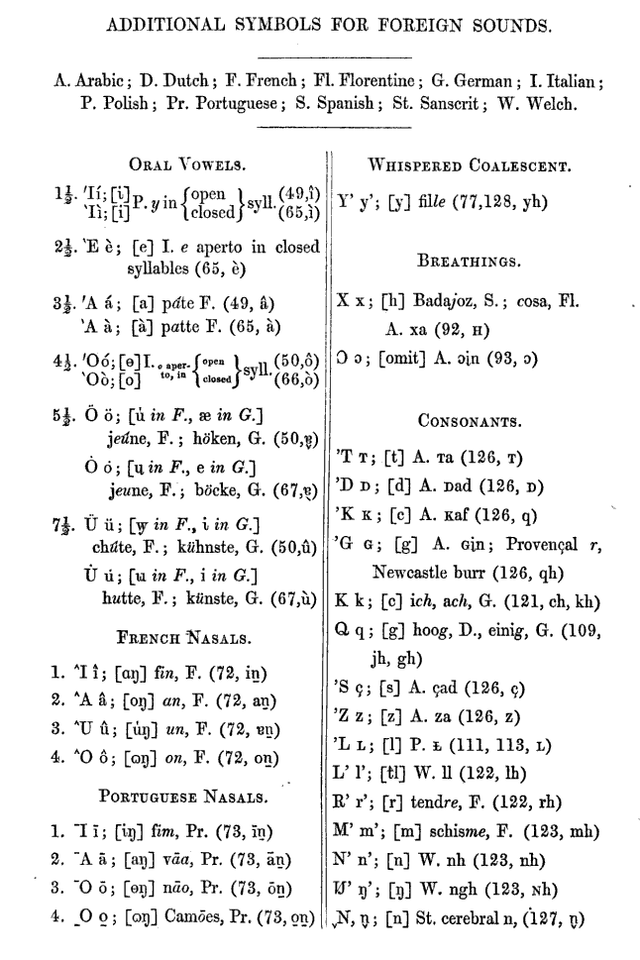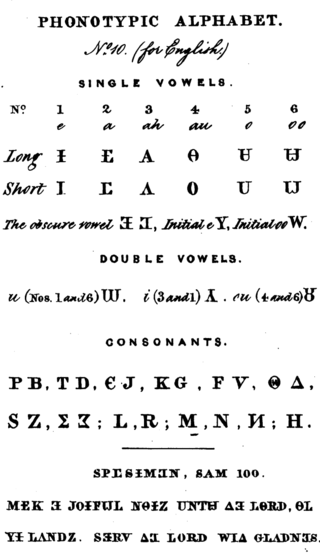Top Qs
Timeline
Chat
Perspective
English Phonotypic Alphabet
Phonetic alphabet developed by Isaac Pitman and Alexander John Ellis From Wikipedia, the free encyclopedia
Remove ads
The English Phonotypic Alphabet is a phonetic alphabet developed by Sir Isaac Pitman and Alexander John Ellis originally as an English language spelling reform.[2] Although never gaining wide acceptance, elements of it were incorporated into the modern International Phonetic Alphabet.[3]





It was originally published in June 1845.[4] Subsequently, adaptations were published which extended the alphabet to the German, Arabic, Spanish, Tuscan, French, Welsh, Italian, Dutch, Polish, Portuguese and Sanskrit languages.[5]
26 EPA letters are in the pipeline for publication by Unicode in 2026.[6]
Remove ads
Etymology
The English Phonotypic Alphabet was a phonotype, which is a phonetic form of printing derived from the Greek root "phon-" for voice and "-typ" for type.[7][8] As such, Pitman and Ellis gave their alphabet the alternative name of Phonotypy or, even more phonetically, Fonotypy. It was designed to be the print form extension of Pitman Shorthand, a form of abbreviated phonetic handwriting.[9] It is closely associated with Phonetic Longhand, which is the handwritten, or script, form of Phonotypy.[10]
Remove ads
Purpose
The philosophical case for the English Phonotypic Alphabet was made by Alexander John Ellis, who conducted an extensive study of the problems with English orthography, which he published in his treatise Plea for Phonetic Spelling, or the Necessity of Orthographic Reform, in 1848.[11] Learned societies such as the London Philological Society and education journals such as The Massachusetts Teacher debated the arguments for reform and the utility of the English Phonotypic Alphabet.[12][13]
Unexpectedly, when the English Phonotypic Alphabet was trialled to teach literacy, it was discovered that after learning to read & write, students effortlessly transitioned their literacy skills to traditional English orthography. This also gave purpose to the English Phonotypic Alphabet being used as a transitional mechanism to improve the teaching of literacy.[14][15]
Remove ads
Teaching Literacy
Summarize
Perspective

The ultimate objective of the English Phonotypic Alphabet was to improve literacy levels; as such, to demonstrate its efficacy, it was trialled for teaching literacy in many different settings. It was mainly tried in schools with children but also illiterate inmates of workhouses, reformatories and jails and by missionaries in Africa, China & India. In 1849, its potential was shown when 1,300 Mancunian illiterates were taught to read and write in only a few months.[16]
These trials culminated in the adoption of the English Phonotypic Alphabet in two public school districts in the United States: - Waltham, Massachusetts, between 1852 & 1860 and Syracuse, New York, between 1850 & 1866. Both districts used a variant of the English Phonotypic Alphabet known as the Cincinnati Phonotypy or the American Phonetic Alphabet.[17] This type was used by Longley Brothers to publish a set of reading-books: - a first phonetic reader, a second phonetic reader, and a transition reader.[18][19][20]
Waltham

In the 1852-53 annual report of Waltham's school committee, the chairman, Reverend Thomas Hill, reported the effect of Phonotypy on the 800 pupils within the ten schools: –[21]
"It has been proved in repeated experiment that if a child upon his first learning his letters, is taught the Phonetic Alphabet, and is confined to Phonetic books for the first six to eight months of schooling, he will at the end of the first year's schooling read common print and spell in common spelling better than children will ordinarily do at the end of four or five year's instruction."[22]
Syracuse

Bothe's analysis of the course of study for the Syracuse school district measured the improvement from using Phonotypy: -
In 1855, before the introduction of the transitional alphabet, the student was expected to finish reading Webb's Second Reader by the end of the third grade. In 1858, the first year in which phonetic texts appeared in the course of study, Webb's Second Reader was entirely completed two-thirds through the second grade (four trimesters gained).[23]
Successor

Dr Edwin Leigh extensively practised using Phonotypy to teach literacy. He became persuaded of its efficacy and a passionate advocate but failed to convince his own St. Louis school district to adopt it. He concluded that Phonotypy was not widely accepted because parents, teachers, and district officials could not understand the orthography themselves.[24]

Phonotypy had never been designed as a transitionary mechanism to attain literacy in standard English; instead, people had only realised it could be used this way after it was launched. Subsequently, Leigh designed a successor, Pronouncing Orthography, which was explicitly designed for this purpose, and to this end, it superseded Phonotypy as a transitory orthography toward literacy.[25]
Remove ads
Citations
See also
References
External links
Wikiwand - on
Seamless Wikipedia browsing. On steroids.
Remove ads
